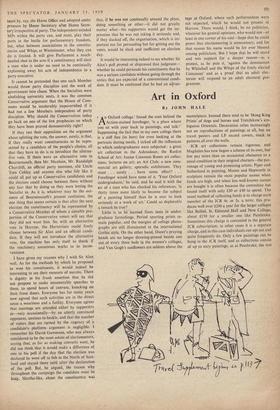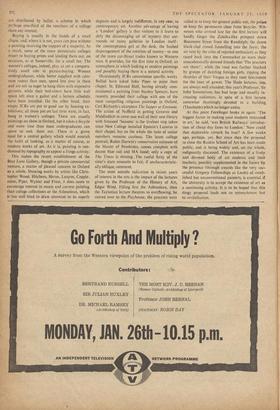Art in Oxford
By JOHN HALE A N Oxford college,' hissed the man behind the
A
Action-stained forefinger, 'is a place where you sit with your back to paintings, and talk !' Suppressing the fact that in my own college there is a stiff fine (in beer) for even looking at the portraits during meals, I ticked off the influences to which undergraduates were subjected : a great art collection in the Ashmolean; the Ruskin School of Art; Junior Common Room art collec- tions; lectures on art; an Art Club; a new com- mercial art gallery; sporadic exhibitions. They must . . . surely . . . have some effect? . . . Forefinger would have none of it. 'Your Oxford undergraduate,' he said, and he said it with the air of a man who has checked his references, 'is thirty times more likely to become the subject of a painting himself than he is ever to look seriously at a work of art.' Could so deplorable a remark be true?
Little is to be learned from taste in under- graduate furnishings. Period sporting prints re- main popular, and the margins of college photo-• graphs are still illuminated in the international Gothic style. On the other hand, Durer's praying hands are no longer drawing-pinned beside one out of every three beds ip the women's colleges, and Van Gogh's sunflowers are seldom above the mantelpiece. Instead there tend to be 'Hong King Prints' of dogs and horses and Tretchikow's am- biguous Orientals. Decoration relies increasingly not on reproductions of paintings at all, but on travel posters and LP record covers, stuck in patterns all over the walls.
JCR art collections remain vigorous, and Magdalen has now begun a scheme of its own, but few pay more than an occasional obeisance to a usual condition in their original charters—the pat- ronage of young and promising artists; Piper and Sutherland in painting, Moore and Hepworth in• sculpture remain the most popular names when funds are high, and when less well-known names' are bought it is often because the committee has found itself with only £30 or £40 to spend. The usual method of collecting funds is to charge each member of the JCR 4s. or 5s. a term; this pro- duces well over £200 a year for the larger colleges like Balliol, St. Edmund Hall and New College, about £150 for a smaller one like Pembroke. Sometimes this charge is concealed in the general JCR subscription; in other cases it is a separate charge, and in this case individuals can opt out and quite frequently do. Only a few paintings can he hung in the JCR itself, and as collections consist of up to sixty paintings, as at Pembroke, the rest are distributed by ballot, • a scheme in which perhaps one-third of the members of a college show any interest.
Buying is usually in the hands of a small clique, and, where it is not, years can pass without a painting receiving the support of a majority. As a result, some of the more democratic colleges resort to buying prints and lending them out, on occasion, as at Somerville, for a small fee. The women's colleges, indeed, play as yet a compara- tively small role in picture-buying. Women undergraduates, while better supplied with com- mon rooms than men, spend less time in them and are not so eager to hang them with expensive pictures, while their bed-sitters have little wall space left once a guitar and a lecture schedule have been installed. On the other hand, their empty JCRs are put to good use by housing ex- hibitions; all those put on last term were, in fact, hung in women's colleges. There are usually paintings on show in Oxford, but it takes a bicycle and more time than most undergraduates can spare to seek them out. There is a grave need for a central gallery which would nourish the habit of looking, as a matter of course, at modern works of art. As it is, painting is con- demned by topography to appear a fringe activity.
This makes the recent establishment of the Bear Lane Gallery, though a private commercial venture, a matter of pleased concern to Oxford as a whole. Showing works by artists like Chris- topher Wood, Hitchens, Heron, Lanyon, Copple- stone, Piper, Wynter and Frost, it does more to encourage interest in recent and current painting than college collections or the Ashmolean, which is too well bred to draw attention' to its superb deposits and is largely indifferent, in any case, to contemporary art. Another advantage of having a 'London' gallery is that visitors to it learn to defy the discouraging air of mystery that sur- rounds so many galleries in London itself : the contemptuous girl at the desk, the hushed disparagement of the mention of money—in one of the more cut-throat trades known to Western man. It provides, for the first time in Oxford, an atmosphere in which looking at modern paintings and possibly buying them is a natural activity.
Occasionally, JCRs commission specific works. Balliol have asked John Piper to paint their chapel. St. Edmund Hall, having already com- missioned a painting from Stanley Spencer, have recently provided their college with one of the most compelling religious paintings in Oxford, Ceri Richards's altarpiece The Supper at Emmaus. The action of Nuffield in getting Greaves and Middleditch to cover one wall of their new library with frescoed 'Seasons' is the liveliest step taken since New College installed Epstein's Lazarus in their chapel, but on the whole the taste of senior members remains cautious. The latest college portrait, Robin Darwin's conservative estimate of the Master of Pembroke, comes complete with decent blue suit and MA hood; only a copy of The Times is missing. The rueful fixity of the sitter's stare amounts to fair, if uncharacteristic- ally oblique, comment.
The most notable indication in recent years of interest in the arts is the impact of the lectures given by the Professor of the History of Art, Edgar Wind. Filling first the Ashmolean, then the Taylorian lecture theatres to overflowing, he moved over to the Playhouse; the proctors were called in to keep the general public out, the police to keep the pavements clear from bicycles. Wit- nesses who arrived late for the first lecture will hardly forget the Zuleika-like prospect down Beaumont Street from the Randolph; the dense black-clad crowd funnelling into the foyer, the air rent by the cries of rejected enthusiasts as they raced back into the Cornmarket to warn their unacademically dressed friends that 'The proctors are there!', while the road was further blocked by groups of dazzling foreign girls, zipping the throttles of their Vespas as they sued latecomers for the loan of gowns. The Slade lectures, too, are always well attended; this year's Professor, Sir John Summerson, has had large and steadily in- creasing audiences, in spite of a first lecture somewhat dauntingly devoted to a building (Theobalds) which no longer exists.
At this point Forefinger broke in again. 'The biggest factor in making your students interested. in art,' he said, 'was British Railways' introduc- tion of cheap day fares to London.' Now could that deplorable remark be true? A few weeks ago, perhaps, yes. But since then the proposal to close the Ruskin School of Art has been made public, and is being widely and, on the whole, indignantly discussed. The existence of a lively and devoted body of art students and their teachers, possibly supplemented in the future by the presence (through awards like the very suc- cessful Gregory Fellowships at Leeds) of estab- lished but unconventional painters, is essential if the university is to accept the existence of art as a continuing activity. It is to be hoped that this dingy proposal leads not to retrenchment but to revitalisation.











































 Previous page
Previous page